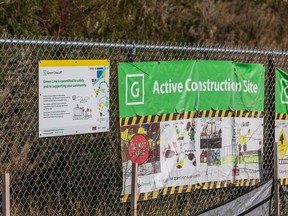Research paper finds common missteps can led to sticker shock for major transit infrastructure and explains how such problems can be avoided

Article content
In a much-anticipated announcement, the province on Friday unveiled its choice for a new downtown Calgary alignment for the Green Line LRT project.
Advertisement 2
Article content
Article content
Article content
Alas, apart from being able to say what streets it will run on, where the line will ends and it will be built entirely above ground — the latter being a foregone conclusion — there was not much new to share on the $6.2-billion endeavour, not even an engineering report.
This lack of openness is just one of the symptoms plaguing some new public transportation infrastructure in many parts of the world where, as it is with the beleaguered Green Line, costs have risen wildly not only over the life of any given project but also for projects in general over the span of decades.
And while a new paper by Jedwin Mok, Balthazar Crane, Marco Chitti, Amer Shalaby for the University of Toronto’s School of Cities doesn’t mention the Green Line, some of the problems they outlined are eerily familiar.
Article content
Advertisement 3
Article content

International transit projects show how to contain costs
“Our study contends that high transit construction costs are not an inevitability; rather, they are the result of a project delivery regime antithetical to global best practices,” wrote the three transit planner and one engineer who co-authored Understanding the Driver of Transit Construction Costs in Canada: A Comparative Study, published on Dec. 4.
The study identified a rise in the cost of many transit projects well beyond the rate of inflation in Canada, the United States, Hong Kong, Singapore, the United Kingdom and Australia over the past 25 years.
That said, some projects within Canada — Vancouver’s Canada Line SkyTrain, Kitchener-Waterloo’s ION light rail and Montreal’s REM light metro — fared much better in terms of cost. Meanwhile, transit projects in Italy, Spain, South Korea and Turkey held steady relative to inflation over the same time period, the authors found.
Advertisement 4
Article content
First, we may be making things too complicated for no good reason.
The report found the construction cost of a fully underground automated metro system in Milan was about one-third less per kilometre than some simpler ground-level tram projects in Canada.
“Canadian transit agencies tend to overbuild in multiple ways, with larger and deeper tunnels and stations — a result of greater risk aversion,” the paper’s authors wrote.
This is partly due to “stricter interpretations of global safety standards than other, more cost-effective jurisdictions.”
Recommended from Editorial
Project procurement practices can lead to headaches
Advertisement 5
Article content
They also singled out routing and construction choices made to appease locals — tunnelling deep to avoid causing disruptions, for example. “However, these often come at high cost,” the paper said, highlighting savings from shallow tunnelling or above-ground options.
The authors went on to criticize procurement, arguing work is being offloaded to external consultants too early in the process, before projects are fully scoped and properly priced.
They also argued keeping more work within the public sector would allow for better knowledge retention, leading to cost savings thanks to improved institutional memory.
“Advancing project design in-house empowers civil servants to take ownership of and make decisions on projects, increasing cost confidence and controlling soft costs by minimizing change orders and delays,” the paper argued.
Advertisement 6
Article content

Study authors frown upon lack of transparency
The study also took aim at budget contingencies. The authors found some instances of emergency reserves being used as line items for expected spending.
“The continuously escalating per-kilometre costs in Canada indicate a persistent trend of overpadding,” they wrote.
The authors were also critical of practices that hide information from the public.
“Low-cost jurisdictions emphasize public transparency, enabling more cost-effective planning and decision-making. They avoid lump-sum contracts that make costs opaque and change orders more difficult to track,” they continued. “In comparison, high-cost jurisdictions like New York and Toronto consider cost estimates to be akin to trade secrets, citing their commercial sensitivity to prevent public disclosure.”
Not always following global best practices led to the trouble we’ve seen with the Green Line since before Day 1 — an sometimes ill-defined initial concept coupled with occasional opaque management practices, leading to escalating costs and continual reductions in project scope.
With hope, it’s not too late to start doing things right.
Article content






